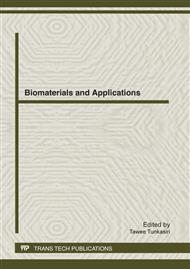p.587
p.591
p.595
p.599
p.603
p.607
p.611
p.615
p.619
Effect of Molecular Sizes, Sources of Chitosan and Plasticizer Types on Properties of Carboxymethyl Chitosan Films
Abstract:
Carboxymethyl chitosan (CMCH) from two molecular sizes (oligomer and polymer) and three different sources (shrimp, crab and squid) of chitosan were prepared by carboxymethylation reaction. The CMCH films were cast and their mechanical properties. For molecular sizes, the polymer CMCH films showed higher %elongation (%E) than those of oligomer CMCH films but had no effect on tensile strength (TS). The crab polymer CMCH films showed the highest TS. The different sources of chitosan had no influence on %E of CMCH films. The effect of plasticizers [glycerol (Gly), sorbitol (Sor) and polyethylene glycol 400 (PEG)] on mechanical properties of CMCH films was also investigated. Additions of Gly and Sor into films increased %E and reduced TS of CMCH films; however, films plasticizing with PEG showed no significant difference in mechanical properties. The crab CMCH films were selected to determine water vapor transmission rate (WVTR) at 25°C and 65%RH. The crab oligomer CMCH films showed higher WVTR than those of crab polymer CMCH films. Addition of Sor as plasticizer decreased WVTR of crab polymer and oligomer CMCH films whereas WVTR of films with Gly depended on molecular sizes of chitosan. Addition of PEG had no effect on WVTR of CMCH films.
Info:
Periodical:
Pages:
611-614
Citation:
Online since:
April 2012
Authors:
Keywords:
Price:
Сopyright:
© 2012 Trans Tech Publications Ltd. All Rights Reserved
Share:
Citation:


